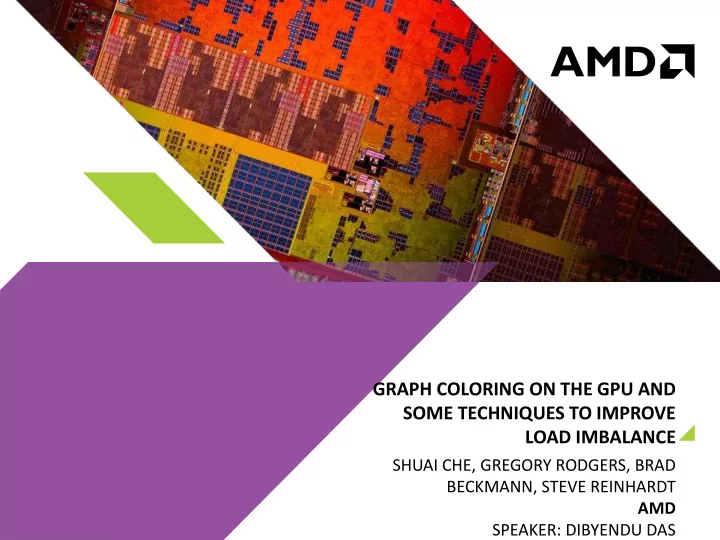

GRAPH COLORING ON THE GPU AND SOME TECHNIQUES TO IMPROVE LOAD IMBALANCE SHUAI CHE, GREGORY RODGERS, BRAD BECKMANN, STEVE REINHARDT AMD SPEAKER: DIBYENDU DAS
GRAPH COLORING Graph coloring is a key building block for many graph applications Graph coloring presents load imbalance across GPU threads Its program behavior changes over time in different iterations ‒ Load distribution across threads ‒ Static approach usually is not effective 2 ASHES| MAY, 2015
GRAPH COLORING Label a graph so that no adjacent vertices have the same color ‒ We do not study optimal coloring in this work 3 ASHES| MAY, 2015
BASELINE COLORING ALGORITHM Randomization-based approach (baseline) Assign vertices with random values Repeat the following steps until all the vertices are colored Each thread checks if a vertex is a local maximum using random numbers If the vertex is a local maximum, assign the vertex a new color else ignore the vertex and evaluate it in the following iteration 4 ASHES| MAY, 2015
BASELINE COLORING ALGORITHM Issues of the baseline algorithm ‒ Different vertices have different degrees ‒ Load Imbalance across GPU threads. Short running threads have to wait for long running threads, wasting compute resources and power We first apply workstealing to balance workloads across workgroups ‒ Each workgroup is associated with a work queue ‒ Each workgroup consists of multiple threads, each of which processes a vertex and its neighborlist ‒ The workstealing algorithm uses a similar approach used by Tsigas and Cedermann ( GPU Computing Gems ) 5 ASHES| MAY, 2015
WORKSTEALING Two basic operations in workstealing Pop dequeues an element from the tail of the local queue Steal dequeues an element from the head of a remote queue, when the local queue is empty 6 ASHES| MAY, 2015
PERFORMANCE OF WORKSTEALING Less than 10% performance improvement 7 ASHES| MAY, 2015
WORKSTEALING Work stealing in the workgroup granularity only partially resolves the overall load imbalance problem Significant imbalance exists within a workgroup, especially for unstructured graphs (e.g., power-law graphs) 8 ASHES| MAY, 2015
A HYBRID APPROACH Vertex degree can be a heuristic to estimate the running time of a thread to process a vertex and its neighborlist We color large-degree vertices first, so that they will not be evaluated in the following iterations. Load imbalance across threads will be improved. 9 ASHES| MAY, 2015
HYBRID ALGORITHM Phase 1 (degree-based coloring) Precalculate degrees of all the vertices Repeat the following steps until a switching condition is met Each thread checks if a vertex is a local maximum using vertex-degree values If the vertex is a local maximum, assign the vertex a new color else ignore the vertex and evaluate it in the following iteration Phase 2 (randomization-based coloring) Repeat the following steps until all the vertices are colored Each thread checks if a vertex is a local maximum using random numbers If the vertex is a local maximum, assign the vertex a new color else ignore the vertex and evaluate it in the following iteration Note: for Phase 1, we only color a vertex if and only if it is a local maximum and it is the only local maximum in the neighborhood 10 ASHES| MAY, 2015
HYBRID ALGORITHM Degree-based coloring will get diminishing benefits because more and more vertices will have smaller, same degrees (e.g. dip and coauthor). Thus, we switch to randomization-based coloring Switch condition: ‒ No. of colorable of vertices using the degree-based approach is less than a threshold For example, no. of colorable vertices is not big enough to fit all the GPU cores ‒ For many unstructured graphs, most of the large-degree vertices can be colored in only a few iterations. 11 ASHES| MAY, 2015
PERFORMANCE BENEFITS The hybrid algorithm is 23% faster than the baseline, randomization-based approach for dip20090126, and 27% faster for coAuthorDBLP The hybrid algorithm is especially effective to color unstructured graphs 12 ASHES| MAY, 2015
ACTIVE VERTICES ACROSS ITERATIONS High-degree vertices are colored in the first few iterations. Load imbalance is improved for the following iterations. 13 ASHES| MAY, 2015
IMPACT OF PHASE CHANGE The best case: switching at the 4 th iteration for dip 15% performance difference between the best and worst cases It is an open research question to determine the optimal switch point. ‒ Currently, some threshold value is used 14 ASHES| MAY, 2015
CONCLUSION AND FUTURE WORK This paper shows the cause of SIMD load imbalance when performing coloring We show workstealing offer only limited performance improvement, due to significant imbalance within a workgroup We propose a hybrid 2-phase graph coloring algorithm with the combination of degree and randomization-based strategies Future work includes: ‒ Extension to multiple machine nodes ‒ Evaluation with different data layouts and inputs ‒ Integration of this algorithm into other graph applications (e.g., independent set) 15 ASHES| MAY, 2015
Recommend
More recommend